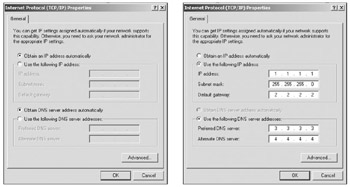Encyclopedia of 802.11 Standards
|
|
Windows XP and 2000
The screens where configuration information can be found look the same on both Windows XP and Windows 2000. Getting to those screens is done a little differently on each Windows version, however.
Windows 2000: Click the Start button, and scroll up to Settings, then across to Network and Dial-up Connections. Select 'Local Area Connection' from the Network and Dial-up Connections menu. The status window for your network adapter will appear. Click on the Properties button in the window. The 'Local Area Connection Properties' window will appear. In the central pane you'll see a list of network protocols. Scroll down to the Internet Protocol (TCP/IP) entry. With that entry highlighted, click Properties.
Windows XP: Click the Start button, and from the Start menu click Control Panel. From the control panel browser, double click Network Connections. The Network Connections applet window will appear. Each of the network adapters installed on your computer will be listed below the heading 'LAN or High-Speed Internet.' You will probably only have one (some computers have several; my own has four!) but make sure that you highlight the adapter to which your broadband modem is connected. (Hint: If you have several adapters listed, see if only one is enabled, and choose that one.) Right-click on your network adapter and select Properties from the context menu. In the Local Area Network Connection properties window that appears, highlight Internet Protocol (TCP/IP) and click the Properties button.
The properties window that appears (for either Windows version) tells the whole story. Figure C.1 shows two such properties windows side by side. What you'll have on your computer should resemble one or the other. On the left is the properties window for dynamic configuration. Not much there: Just two radio button selections indicating that those values are set automatically. On the right is a properties window indicating static configuration. The values for the addresses are artificial, though I can't guarantee that somebody somewhere isn't using them. The point is that real values are present in those fields, and that the fields are not grayed out. Copy them down carefully, or (better still) take and print a screen shot of the window. All the values you'll need are right there in that single window.

Figure C.1: Dynamic (Left) And Static TCP/IP Properties.
|
|
EAN: 2147483647
Pages: 181
- Structures, Processes and Relational Mechanisms for IT Governance
- Integration Strategies and Tactics for Information Technology Governance
- Measuring and Managing E-Business Initiatives Through the Balanced Scorecard
- A View on Knowledge Management: Utilizing a Balanced Scorecard Methodology for Analyzing Knowledge Metrics
- Measuring ROI in E-Commerce Applications: Analysis to Action